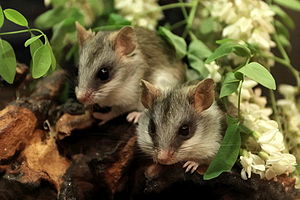Acacia rats
| Acacia rats | ||||||||||||
|---|---|---|---|---|---|---|---|---|---|---|---|---|

Acacia rat ( Thallomys sp. ) |
||||||||||||
| Systematics | ||||||||||||
|
||||||||||||
| Scientific name | ||||||||||||
| Thallomys | ||||||||||||
| Thomas , 1920 |
The acacia rats ( Thallomys ) are a genus of rodents from the group of old world mice (Murinae). The genus includes four species.
Acacia rats reach a head body length of 12 to 16 centimeters, in addition there is a 13 to 21 centimeter long tail. The weight is 63 to 100 grams. Their hair is rather long, the back is colored yellow-gray to gray-brown, with the top being darker than the flanks. The belly is white, as are the paws.
These rodents live in eastern and southern Africa , their range extends from Ethiopia and Somalia to Angola and South Africa . Their habitat are bush lands and other open habitats, they can often be found on acacias . They can climb well and build their nests in the forks of branches or in holes in the roots. Usually a large tree houses a group of these animals, the groups consist of a maximum of two adult pairs and their offspring. Their diet consists of buds, leaves and tree sap, sometimes also insects or fruits.
There are four types:
- Thallomys loringi lives in Kenya and Tanzania.
- Thallomys nigricauda is native to southwest Africa.
- The (actual) acacia rat ( Thallomys paedulcus ) inhabits large parts of eastern and southern Africa.
- Thallomys shortridgei is only found along the Orange River in South Africa.
The endangerment level of T. shortridgei is unclear, as no sightings have been made recently, the other three species are not endangered according to the IUCN .
The acacia rats are systematically part of the Oenomys group within the Old World mice.
literature
- Ronald M. Nowak: Walker's Mammals of the World. 2 volumes. 6th edition. Johns Hopkins University Press, Baltimore MD et al. 1999, ISBN 0-8018-5789-9 .
- Don E. Wilson , DeeAnn M. Reeder (Eds.): Mammal Species of the World. A taxonomic and geographic Reference. 2 volumes. 3. Edition. Johns Hopkins University Press, Baltimore MD 2005, ISBN 0-8018-8221-4 .